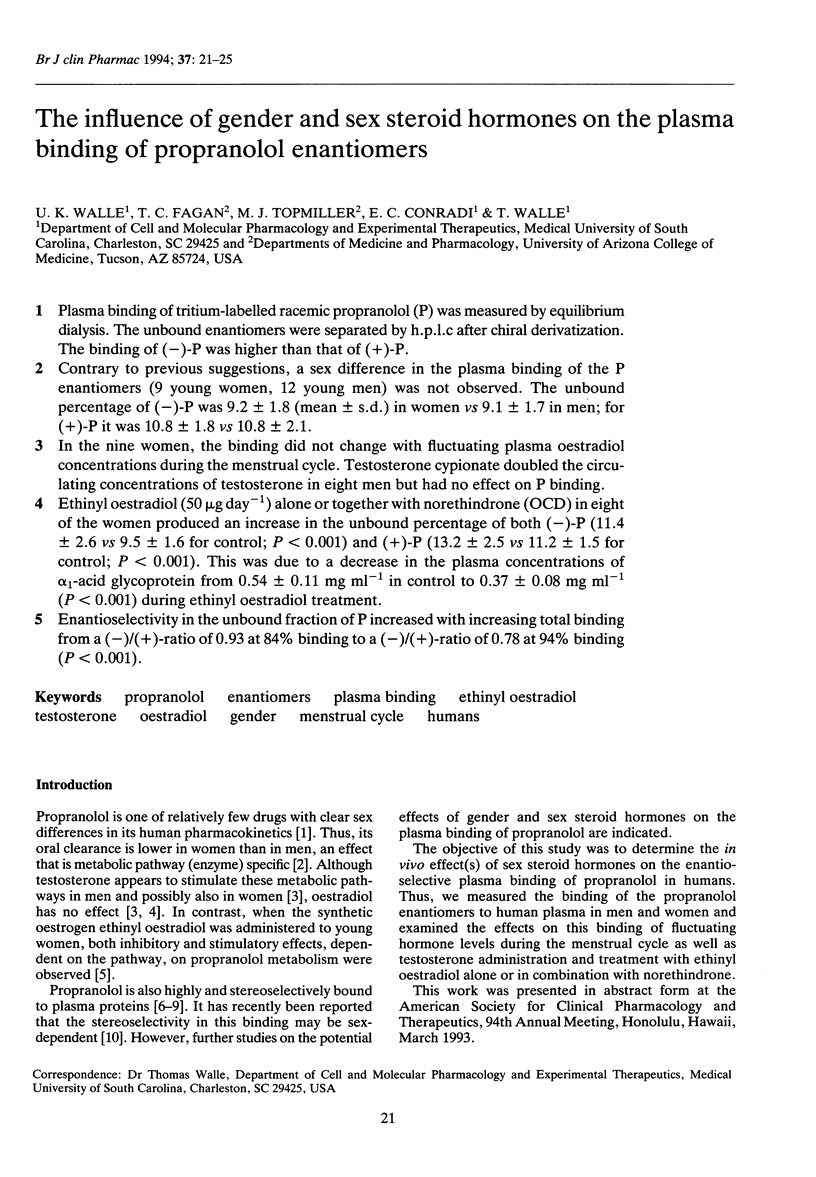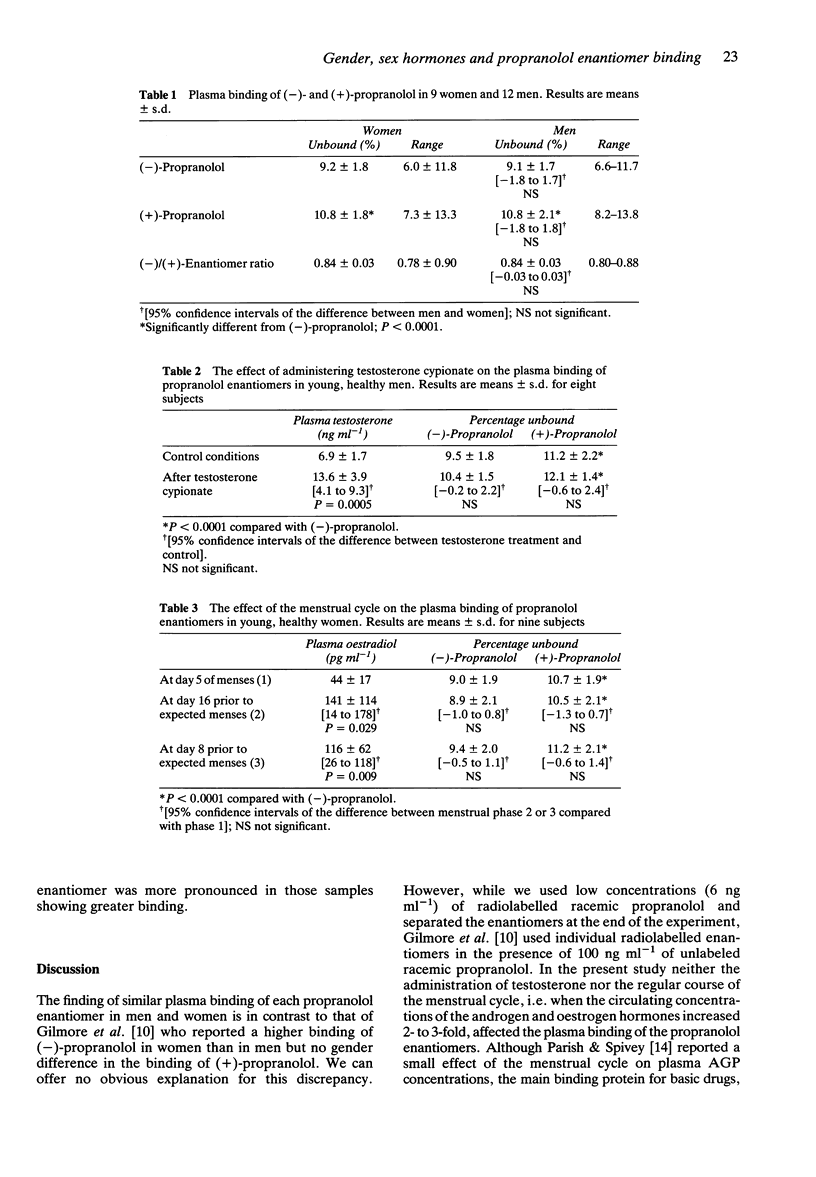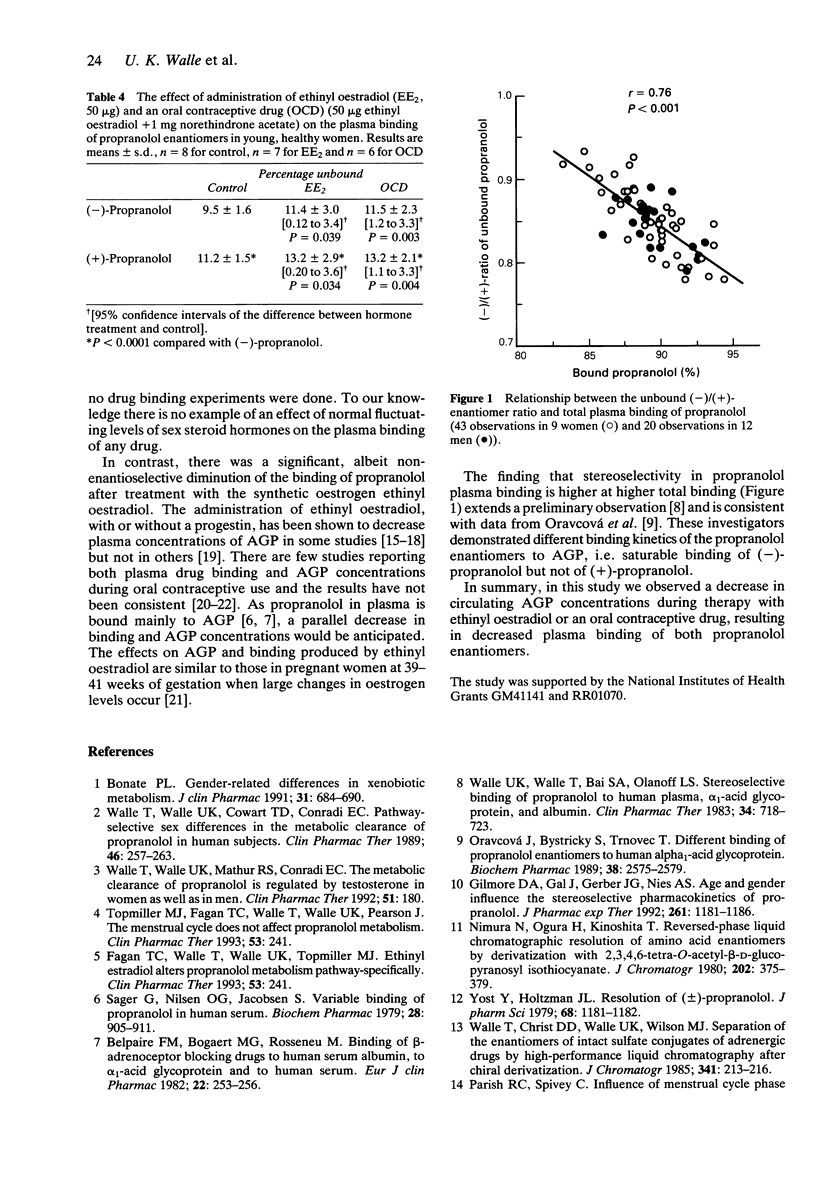Abstract
1. Plasma binding of tritium-labelled racemic propranolol (P) was measured by equilibrium dialysis. The unbound enantiomers were separated by h.p.l.c. after chiral derivatization. The binding of (-)-P was higher than that of (+)-P. 2. Contrary to previous suggestions, a sex difference in the plasma binding of the P enantiomers (9 young women, 12 young men) was not observed. The unbound percentage of (-)-P was 9.2 +/- 1.8 (mean +/- s.d.) in women vs 9.1 +/- 1.7 in men; for (+)-P it was 10.8 +/- 1.8 vs 10.8 +/- 2.1. 3. In the nine women, the binding did not change with fluctuating plasma oestradiol concentrations during the menstrual cycle. Testosterone cypionate doubled the circulating concentrations of testosterone in eight men but had no effect on P binding. 4. Ethinyl oestradiol (50 micrograms day-1) alone or together with norethindrone (OCD) in eight of the women produced an increase in the unbound percentage of both (-)-P (11.4 +/- 2.6 vs 9.5 +/- 1.6 for control; P < 0.001) and (+)-P (13.2 +/- 2.5 vs 11.2 +/- 1.5 for control; P < 0.001). This was due to a decrease in the plasma concentrations of alpha 1-acid glycoprotein from 0.54 +/- 0.11 mg ml-1 in control to 0.37 +/- 0.08 mg ml-1 (P < 0.001) during ethinyl oestradiol treatment. 5. Enantioselectivity in the unbound fraction of P increased with increasing total binding from a (-)/(+)-ratio of 0.93 at 84% binding to a (-)/(+)-ratio of 0.78 at 94% binding (P < 0.001).
Full text
PDF




Selected References
These references are in PubMed. This may not be the complete list of references from this article.
- Belpaire F. M., Bogaert M. G., Rosseneu M. Binding of beta-adrenoceptor blocking drugs to human serum albumin, to alpha 1-acid glycoprotein and to human serum. Eur J Clin Pharmacol. 1982;22(3):253–256. doi: 10.1007/BF00545224. [DOI] [PubMed] [Google Scholar]
- Blain P. G., Mucklow J. C., Rawlins M. D., Roberts D. F., Routledge P. A., Shand D. G. Determinants of plasma alpha 1-acid glycoprotein (AAG) concentrations in health. Br J Clin Pharmacol. 1985 Nov;20(5):500–502. doi: 10.1111/j.1365-2125.1985.tb05107.x. [DOI] [PMC free article] [PubMed] [Google Scholar]
- Bonate P. L. Gender-related differences in xenobiotic metabolism. J Clin Pharmacol. 1991 Aug;31(8):684–690. doi: 10.1002/j.1552-4604.1991.tb03760.x. [DOI] [PubMed] [Google Scholar]
- Gilmore D. A., Gal J., Gerber J. G., Nies A. S. Age and gender influence the stereoselective pharmacokinetics of propranolol. J Pharmacol Exp Ther. 1992 Jun;261(3):1181–1186. [PubMed] [Google Scholar]
- Laurell C. B., Kullander S., Thorell J. Effect of administration of a combined estrogen-progestin contraceptive on the level of individual plasma proteins. Scand J Clin Lab Invest. 1968;21(4):337–343. doi: 10.3109/00365516809077003. [DOI] [PubMed] [Google Scholar]
- Oravcová J., Bystricky S., Trnovec T. Different binding of propranolol enantiomers to human alpha 1-acid glycoprotein. Biochem Pharmacol. 1989 Aug 15;38(16):2575–2579. doi: 10.1016/0006-2952(89)90540-6. [DOI] [PubMed] [Google Scholar]
- Parish R. C., Spivey C. Influence of menstrual cycle phase on serum concentrations of alpha 1-acid glycoprotein. Br J Clin Pharmacol. 1991 Feb;31(2):197–199. doi: 10.1111/j.1365-2125.1991.tb05515.x. [DOI] [PMC free article] [PubMed] [Google Scholar]
- Piafsky K. M., Borgå O. Plasma protein binding of basic drugs. II. Importance of alpha 1-acid glycoprotein for interindividual variation. Clin Pharmacol Ther. 1977 Nov;22(5 Pt 1):545–549. doi: 10.1002/cpt1977225part1545. [DOI] [PubMed] [Google Scholar]
- Sager G., Nilsen O. G., Jacobsen S. Variable binding of propranolol in human serum. Biochem Pharmacol. 1979 Mar 15;28(6):905–911. doi: 10.1016/0006-2952(79)90374-5. [DOI] [PubMed] [Google Scholar]
- Song C. S., Merkatz I. R., Rifkind A. B., Gillette P. N., Kappas A. The influence of pregnancy and oral contraceptive steroids on the concentration of plasma proteins. Studies with a quantitative immunodiffusion method. Am J Obstet Gynecol. 1970 Sep 15;108(2):227–231. doi: 10.1016/0002-9378(70)90301-7. [DOI] [PubMed] [Google Scholar]
- Walle T., Christ D. D., Walle U. K., Wilson M. J. Separation of the enantiomers of intact sulfate conjugates of adrenergic drugs by high-performance liquid chromatography after chiral derivatization. J Chromatogr. 1985 May 31;341(1):213–216. doi: 10.1016/s0378-4347(00)84031-1. [DOI] [PubMed] [Google Scholar]
- Walle T., Walle U. K., Cowart T. D., Conradi E. C. Pathway-selective sex differences in the metabolic clearance of propranolol in human subjects. Clin Pharmacol Ther. 1989 Sep;46(3):257–263. doi: 10.1038/clpt.1989.136. [DOI] [PubMed] [Google Scholar]
- Walle U. K., Walle T., Bai S. A., Olanoff L. S. Stereoselective binding of propranolol to human plasma, alpha 1-acid glycoprotein, and albumin. Clin Pharmacol Ther. 1983 Dec;34(6):718–723. doi: 10.1038/clpt.1983.240. [DOI] [PubMed] [Google Scholar]
- Wanwimolruk S., Kaewvichit S., Tanthayaphinant O., Suwannarach C., Oranratnachai A. Lack of effect of oral contraceptive use on the pharmacokinetics of quinine. Br J Clin Pharmacol. 1991 Feb;31(2):179–181. doi: 10.1111/j.1365-2125.1991.tb05509.x. [DOI] [PMC free article] [PubMed] [Google Scholar]
- Wood M., Wood A. J. Changes in plasma drug binding and alpha 1-acid glycoprotein in mother and newborn infant. Clin Pharmacol Ther. 1981 Apr;29(4):522–526. doi: 10.1038/clpt.1981.73. [DOI] [PubMed] [Google Scholar]
- Yost Y., Holtzman J. L. Resolution of (+/-)-propranolol. J Pharm Sci. 1979 Sep;68(9):1181–1182. doi: 10.1002/jps.2600680935. [DOI] [PubMed] [Google Scholar]


